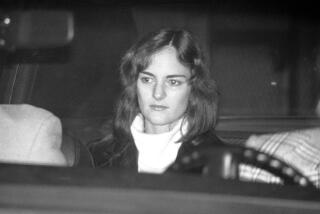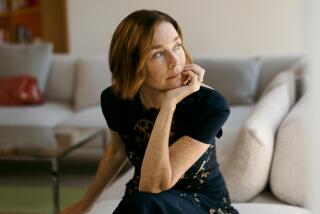Two Famous Daughters Involved in One Very Notorious Story
- Share via
Standing back-to-back in a publicity photo for the film “Patty Hearst” are two daughters from different sorts of privilege--Patricia Hearst Shaw and the actress who’s playing her in a new film, Natasha Richardson.
That the pair--who already resemble each other physically--are coiffed and dressed alike reinforces their shared ground, and highlights their differences.
For the record:
12:00 a.m. Sept. 21, 1988 For the Record
Los Angeles Times Wednesday September 21, 1988 Home Edition Calendar Part 6 Page 7 Column 4 Entertainment Desk 1 inches; 26 words Type of Material: Correction
Nicholas Kazan wrote the script for the film “Patty Hearst” and Paul Schrader was the director. A story in Monday’s Calendar incorrectly credited Schrader with writing the screenplay.
One is the scion of one of America’s most famous media families, the Hearsts. Patty Hearst, because of her 1974 kidnaping and her involvement in an urban guerrilla movement and her subsequent capture, is one of the most written-about women of recent years. The other in the picture is a scion of one of Britain’s great theatrical families, the Redgraves and Richardsons. But the 25-year-old Richardson is only now getting recognition outside her own country.
And any relatively unknown actress taking on the role of Patty Hearst--the title role in Paul Schrader’s film of the same name, opening Friday--has to be prepared to defend her perception and execution of it.
Richardson--who has spent much of her career trying to outrun the “daughter of Vanessa Redgrave and director Tony Richardson” pigeonhole--does not shirk the duty. She hates being interrupted while speaking; is unapologetically opinionated, and, in her acting, depends as much on intuition and impulse as on her thorough-going British training.
Unlike many another American actress considered for the role, though, Richardson is not your impulsive bad-girl actress type, partially because she was enrolled in many of the best European private schools and involved in theater and the entertainment industry early on. And then there’s the fact that she’s a working actress about to have her first star vehicle hit the screen--a rather vulnerable position.
“There is a lot at stake for me with this film; it would be disingenuous of me to say otherwise,” Richardson said, in her trained, well-modulated voice, quite similar to her mother’s. “This is my first American film, in a role so American that many people thought Paul (Schrader, the writer-director) insane to cast me. Just the notoriety of the woman herself would make the film, and the part, a gamble.”
Schrader said there was quite a brouhaha over his insistence that Richardson be used. The film’s backers considered her “a British no-name actress,” Schrader said, claiming they wanted a high-profile American actress for the part.
But there wasn’t any conflict with Patty Hearst whose kidnaping by the Symbionese Liberation Army set off a dramatic series of events 14 years ago when Hearst was a few weeks short of her 20th birthday. Richardson was allowed to pursue her own ideas on what made Hearst tick.
Actually, Richardson recalled, she and Hearst spent some time together in Cannes during the film festival in March where “Patty Hearst” was first screened. (Schrader’s script is considered by some critics to hew quite closely to the book Hearst wrote about her urban terrorist experiences.)
For Richardson, the role of Patty Hearst constituted a double internal struggle: A fight to break free from her classically controlled English-theater training and an attempt to stamp her personal viewpoint on the Patty Hearst experience--a persona so public, in America at least, that practically everyone has an opinion about her.
“I do indeed believe in reading up on a role beforehand, and with Patty there was plenty to read,” said Richardson. “I suppose there existed the danger of overloading on the media accounts of the kidnaping, and of the time and place, but I felt a nudge inside of me that told me when to stop reading and start doing.”
Still, Richardson did enough homework to banish her sculpted British stage accent for a perfectly inflected, flat, standard American one, and she also investigated a time and mind-set that functionally predated her.
“I really came to the project with no cultural baggage at all,” she said. “I was from England, where the Hearst affair was regarded with light curiosity and quite a bit of head-shaking over those ‘strange Americans.’ And I was also 11 when she was abducted, and so had other things on my mind.
“That helped a great deal when the time came for me to actually act on film,” she said. “I didn’t have that defined image of her locked in my brain, and I could be really honest in the scene, unrestrained.”
And then there was Schrader’s nearly hands-off direction of Richardson. “Her instincts are extraordinary--so good I didn’t feel she was missing anything I was looking for,” said Schrader. “Yet she was so prepared that when she came on board and did the preliminary rehearsals, she knew exactly what she had to say. To an extraordinary degree, it’s a performance she created herself.”
Yet there were moments, Richardson said, where her previous work and natural reserve all went by the boards. In the trying psychological and emotional circumstances of playing Patricia Hearst’s quite public “urban terrorist,” there arose situations that confounded her.
“There were times . . . when I’m doing the closet scenes, or the indoctrination bits where, well, where I got so far into things that I completely lost track (of herself), and that was new for me,” Richardson said slowly, lighting a cigarette. “Not that I got lost, but that I began to . . . defend my character (to cast and crew), to explain why I’d come to be there, and so on. I’d think, ‘Urban guerrilla . . . Why am I an urban guerrilla?’
“These moments really surprised me,” Richardson continued, looking away. “I wasn’t really prepared for them at all.”
But one thing Richardson was prepared for was the lessening of the oppressive sense that all was possible because she was you-know-who’s eldest daughter.
After all, Richardson said to herself, acting and the theater are the family business: Her kid sister, Joely, is also an actress, and together the Richardson girls carry on a proud Richardson/Redgrave theater tradition that now stretches back to English actor George Ellsworthy, the father of Richardson’s grandfather, Sir Michael Redgrave. That makes four generations in all, including Vanessa Redgrave, Lynn Redgrave and Rachel Kempson (Sir Michael’s wife).
“When I was younger, say about five years ago, it bothered me a great deal to be constantly compared to my mother, even my grandfather,” said Richardson. “You know, I’d always wanted to be an actress, since I was 6 or 7; I’d never really wanted to do anything else, ‘cause it was so natural. But the ‘family profession’ thing used to tense me up for auditions, because I found that, if anything, you’re put under the microscope even more.”
More to Read
Only good movies
Get the Indie Focus newsletter, Mark Olsen's weekly guide to the world of cinema.
You may occasionally receive promotional content from the Los Angeles Times.










